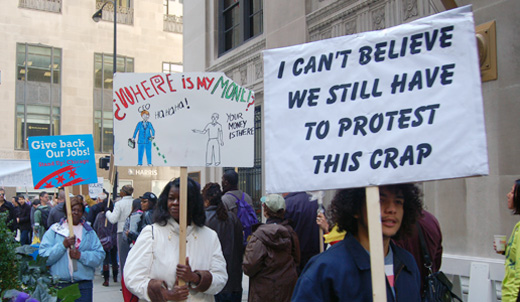
In 2010, economists Carmen Reinhart and Kenneth Rogoff (know in the econ trade as “R & R”) released a paper, “Growth in a Time of Debt.” The paper’s profile was boosted by the authors’ rising fame and reputation from a magisterial study, published also in 2010, of debt and default through the past 1200 years.
The paper and the book became an ideological bulwark of “austerity policy makers”, who exploited it worldwide for right wing purposes, despite the authors’ moderate political views. Reactionary and Blue Dog shills for the banking industry have been flailing around for mainstream economic support for their “hungry dog hunts harder” austerity policies. Until R & R, they had to be satisfied primarily with a cult of “captains of sinking ships”, dressed as economists, known as the Austrian school of economics.
Despite the millions of lost jobs, and mass suffering caused by the banks extracting every dollar from their profligate lending practices, austerity has not led to recovery, but instead to a double dip depression in Europe, and undermining recovery in the U.S.
R & R’s main result asserted that median growth rates for countries with public debt over 90 percent of Gross Domestic Product (GDP) are roughly one percent lower than otherwise; average growth rates are several percent lower. Countries with debt-to-GDP ratios above 90 percent have a slightly negative average growth rate.
This has been one of the most cited stats in the public debate during the Great Recession. Paul Ryan’s Path to Prosperity budget states their study “found conclusive empirical evidence that [debt] exceeding 90 percent of the economy has a significant negative effect on economic growth.” The Washington Post editorial board flatly asserted that this was the “responsible” economic consensus view, stating that “debt-to-GDP could keep rising – and stick dangerously near the 90 percent mark that economists regard as a threat to sustainable economic growth.”
Is it really true? No, it turns out. For several countries cited, the causation is definitely backwards, meaning that slower growth led to higher debt-to-GDP ratios, not the other way around. And it’s not clear that ALL the examples are of this type. Josh Bivens and John Irons made this case at the Economic Policy Institute. This rebuttal assumed that the data in R & R is at least correct. But from the beginning, researchers trying to replicate the paper’s results have complained that Reinhart and Rogoff weren’t releasing the data for their results.
However, in a new paper, “Does High Public Debt Consistently, Stifle Economic Growth? A Critique of Reinhart and Rogoff,” Thomas Herndon, Michael Ash, and Robert Pollin of the University of Massachusetts, Amherst successfully replicate the results. How? After trying to replicate the R & R results and failing, they reached out to Reinhart and Rogoff and they were willing to share their data spreadsheet.
Economist Mike Konczal summarizes:
“They found that three main issues stand out. First, Reinhart and Rogoff selectively exclude years of high debt and average growth. Second, they use a debatable method to weight the countries. Third, there also appears to be a coding error that excludes high-debt and average-growth countries. All three bias in favor of their result, and without them you don’t get their controversial result about the magic 90% debt to GDP ratio.”
The technical glitch in the original R & R paper is mostly important because it has enabled and forced examination of the other flaws that were evident (and pointed out by some) from the start. Fundamentally, bad (austerity) policy was not the result of R & R and other academic papers. Austerity against the 99 percent has been the preferred policy of most of the ruling class for decades, with some differences in how to implement it. The R & R paper was a convenient justification-if it had not been written, others would have been used.
Nonetheless, ideas take on a life of their own. To the extent that the exposure of R & R will make a difference, it probably reflects a growing unease with the dangers posed by the slash-and-burn policies being implemented.
As Paul Krugman notes,
“…the coding error isn’t the biggest story; in terms of the economics, the real point is that R & R‘s results were never at all robust… But economists have been making these points for years, to no avail. It took the shock of an outright, embarrassing error to shake the faith of the Very Serious People in a result they really wanted to believe. … my vague, unquantifiable sense is that the debacle is changing the conversation quite a lot, even among the guys in suits. And it was the coding error that did it.”
Photo: Protesters march in Chicago’s financial district. Peoplesworld.org












Comments